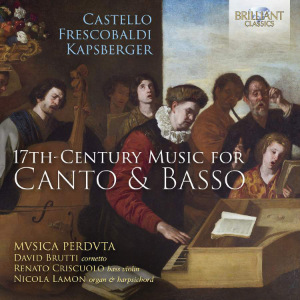
17th Century Music for Canto & Basso
Mvsica Perdvta
rec. 2022, Museum of S. Francesco, Trevi, Italy
Reviewed as a stereo 16/44 download from Naxos
Brilliant Classics 96343 [54]
Many instrumental works of the early 17th century come with the addition a 2, canto e basso. This indicates that it comprises two parts. One is probably inclined to think that the word basso refers to the basso continuo. After all, one of the novelties of the style that emerged around 1600 was the figured bass, to be worked out by a chordal instrument, such as a harpsichord, an organ, a harp or a theorbo. However, it usually indicates the need of a bass instrument, which is given an obbligato part to play. That is the case in the pieces that the ensemble Mvsica Perdvuta brought together for this recording.
All but one of the pieces included here are from the pen of Girolamo Frescobaldi and Dario Castello respectively. Frescobaldi was mainly known as a brilliant organist and composer of keyboard music In the late 1620s he published collections of vocal and instrumental music in a more restrained style, strongly rooted in the stile antico, but with elements which are in accordance with the style of the time, especially in the department of ornamentation and figuration. The canzonas published in 1628 are intended for all sorts of instruments (per sonare con ogni sorte di stromenti). In 1634 a second edition came from the press, which included ten new works and a number of pieces from the edition of 1628, some of them reworked. The number of parts varies from one to four. The fact that some are indicated as being scored for one instrument already indicates that the basso continuo is not specifically mentioned. The present disc includes six canzonas for two voices. The scores specify that they are for canto e basso, but do not mention the instruments. This is left to the performers. These pieces are quite popular among instrumental ensembles, but unfortunately the bass part is often performed on the cello. However, the (baroque) cello as we know it today made its appearance only in the last decades of the 17th century. In Frescobaldi’s time the common string bass instruments were the viola da gamba and the bass violin. Here Renato Criscuolo plays the latter. It produces a pretty strong sound which makes it perfectly suitable to dialogue with the cornett.
The sonatas by Dario Castello are also very common these days. They are often included in anthologies, and several discs are entirely devoted to one of the two volumes of his Sonate concertate in stil moderno, which were published in Venice in 1621 and 1629 respectively. Again, both volumes refer to diversi instrumenti, which suggests that the choice of instruments is left to the performers. However, it is notable that many sonatas specify the instruments to be used. Mvsica Perdvta plays two sonatas from the first volume. Both have the addition fagotto e violin. The two sonatas from the second volume offer a little more freedom. The upper part is designed as sopran, which can be any instrument in the treble range, whereas the second is for fagotto overo viola. This indicates that the bassoon (or dulcian) can be replaced by a bass string instrument. It is not easy to decide what amount of freedom Castello has left to the interpreters to choose the instruments. It seems that the common opinion among performers is that the indications of the instruments in the titles of the different sonatas are merely suggestions rather than prescriptions. We will probably never know. Fact is that composers had to be pragmatic in their indications of the scoring. There was quite a variety of instruments at the time, and often they avoided to be too idiomatic as to exclude certain instruments. From that perspective the option of a bass violin for the lowest part is defendable.
It is interesting anyway, because the bass violin is not a very common instrument these days. That is regrettable, and that makes this recording all the more interesting and important. It is also a valuable alternative to existing recordings of this repertoire. Moreover, we have some excellent artists here. Recently I reviewed a recording by David Brutti and Nicola Lamon, together the ensemble Seicento Stravagante (https://musicwebinternational.com/2023/05/music-for-cornetto-and-keyboard-bis), with repertoire from the same period, but then for cornett (or other treble instruments) and basso continuo. In a way this disc is a sequel, and the quality is just the same. Lamon plays two keyboard pieces here, both by Frescobaldi. What an exciting piece Toccata quinta sopra i pedali dell’organo e senza is, attesting to the experiments with harmony at the time, as it is full of dissonants and chromaticism. These features come fully off thanks to the use of an organ from 1509, which has the appropriate temperament. David Brutti and Renato Criscuolo are virtuosos on their respective instruments and fully acquainted with the style of the early baroque period. The efforts of these three artists results in a compelling display of the brilliant music that was written in Italy in the first half of the 17th century. With Castello’s Sonata VIII from Book 2 they saved the most exciting piece for the end.
Johan van Veen
www.musica-dei-donum.org
twitter.com/johanvanveen
Help us financially by purchasing from



Contents
Dario Castello (1602-1631)
Sonata VII (Libro II)
Girolamo Frescobaldi (1583-1643)
Canzona decimaottava a 2, canto e basso ‘La Masotti’
Dario Castello
Sonata VIII (Libro I)
Girolamo Frescobaldi
Canzona vigesimaseconda a 2, canto e basso ‘La Nicolina’
Canzona ottava ‘La Vincenti’
Giovanni Girolamo Kapsperger (c1580-1651)
Sinfonia Terza
Girolamo Frescobaldi
Canzona vigesimaprima a 2, canto e basso ‘La Tegrimuccia’
Dario Castello
Sonata VII (Libro I)
Girolamo Frescobaldi
Canzona decimanona a 2, canto e basso ‘La Capriola’
Toccata quinta sopra i pedali dell’organo e senza
Canzona vigesima a 2, canto e basso ‘La Lipparella’
Canzona vigesimaterza a 2, canto e basso ‘La Franciotta’
Dario Castello
Sonata VIII (Libro II)


















